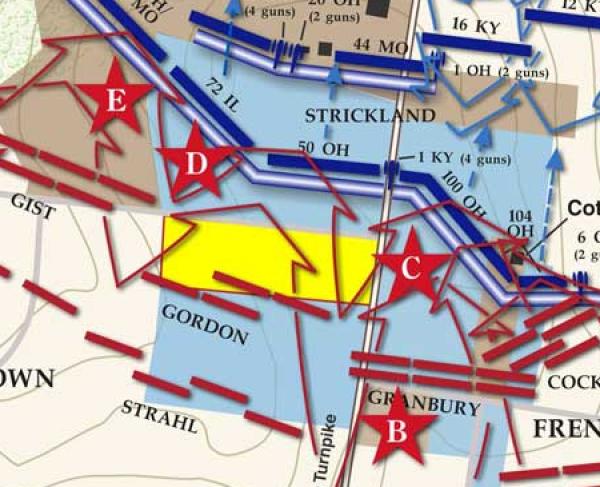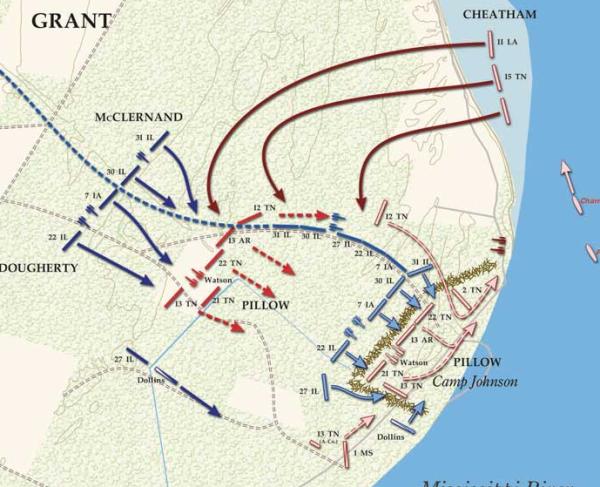
Richmond Battlefield Park, Madison County, Ky.
Help Us Save Hallowed Ground in Tennessee and Kentucky
The Opportunity
Five different allies who share our commitment to battlefield preservation are providing key matching funds to help us purchase and preserve four valued sites in Tennessee and Kentucky.
These sites may be small, but they’re all important, and they are all threatened. And thanks to this amazing match, and your generosity, we’re in a perfect position to beat the odds and purchase not one, not two, but all four of them with an astonishing match of $117-to-$1.
Your gift today will help unlock an astounding $13.75 million in potential federal, state, and local matching funds when we raise just $118,000.
Please help beat the odds — and save more of America’s history — by contributing generously today!
The History
Battle of Franklin
On this hallowed ground, 28,000 Union soldiers under General John Schofield dug in and held on against Confederate General John Bell Hood and his 27,000 boys in gray.
During six hours of some of the most brutal combat of the entire war — the soldiers who wrote letters or left memoirs universally used the word “slaughter” — the armies were locked in a death struggle, often separated by no more than a few feet of earthworks.
It was certain death for a man on either side to raise his head above these works, so they furiously loaded, stretched their aching arms over the top, held their guns aloft, and fired blindly into the opposite side of the mound of earth. The bodies of the dead and wounded piled up like cordwood. The trenches literally ran red with blood.
Although the Confederates held the field after the battle, Private Sam Watkins, noted the following in his book Company Aytch:
“It is the blackest page in the history of the war. It was the bloodiest battle of modern times in any war. It was the finishing stroke to the independence of the Southern Confederacy. I was there. I saw it. My flesh trembles, and creeps, and crawls when I think of it today.”
Hood’s army was crippled at Franklin. In that one unimaginable November afternoon, six of his generals were killed or captured (including arguably the South’s best division commander, Patrick Cleburne), another six generals were wounded, and sixty-five other unit commanders of various ranks were cut down. Many of them, recognizing the long odds before them before the charge even began, dressed in their finest uniforms and wrote their final letters to loved ones.
All told, the Southern army lost 7,300 men that day, 1,800 of them killed outright. The well- entrenched Union forces, however, suffered 2,325 casualties with 189 of the boys in blue dying on the battlefield that day.
The Battle of Franklin may not be as well known to the general public as Gettysburg, Shiloh, or Manassas, but it is every bit as significant as they are.
Battle of Nashville
The Union victory at Nashville shattered Hood's Army of Tennessee and effectively ended the war in Tennessee. Now, we have the chance to save two of the most highly threatened — and extraordinarily expensive — acres at this incredibly well-preserved Union fort in downtown Nashville, protecting this rare site from even more development.
The historic Fort Negley is located in downtown Nashville. The good news is that a combination of anticipated federal, state, and local matching grants will help pay for about 99.7% of the purchase price, leaving us with just 0.3% left to raise! Talk about great partners — we cannot save this land without them!
Battle of Belmont
While it ended inconclusively, the Battle of Belmont was the first test as a battlefield commander of Gen. Ulysses S. Grant, future General-in-Chief of the Union Army, where both sides claimed victory.
Confederate forces thought they won at Belmont since they forced the Union troops to retreat to Paducah, Kentucky. Union forces believed it was their victory since the skirmish resulted in heavy Confederate losses and, according to Grant’s post-war memoirs, the Confederate forces “gave up all idea of detaching troops from Columbus” after the engagement.
Not many figures in American history have overcome longer odds in life than General Ulysses S. Grant.
Before the Civil War, Grant was living in hardscrabble poverty. He failed as a farmer. He sold his gold watch to pay his bills. For a time, he made money by selling firewood in the street.
I’m thinking of General Grant today because he commanded the Union troops at the Battle of Belmont in 1861, his first test as a Civil War battlefield commander, and an experience that would later lead him to say, “It was only then that it occurred to me for the first time that the enemy was just as afraid of me as I was of them.”
You’ve often heard me refer to the battlefield tracts we preserve as being “pieces of a puzzle.” Well today, at Belmont, we have the chance to save another critical piece. This battle was fought on the Missouri side, but troops were also positioned in Kentucky, where this tract is located, immediately adjacent to Fort Quinby, a Confederate-built earthwork (later named by the Union Army). It’s also a stone’s throw from one of our previous acquisitions! Right now, it’s marred by some dilapidated buildings, but soon, with your help, they’ll be torn down and the historic landscape will be restored!
Battle of Richmond
The twenty acres here at the Battle of Richmond could have become acres of tract houses until our allies asked us to work out a preservation transaction to rescue the property.
It would be a tragedy to build a housing subdivision here.
This is the site where, on the morning of August 30, 1862, the Battle of Richmond opened with counterbattery artillery fire for about two hours as Confederate infantry moved into position to assault the flanks of the Federal defensive position centered around Mount Zion Church.
Veteran Confederate sharpshooters from Arkansas and dismounted cavalry from Texas marched unobserved through a ravine now known as Churchill’s Draw and emerged into view of startled newly- recruited soldiers from Indiana and Ohio defending the center and right of the Federal line.
We’re facing long odds, but you can help save hallowed ground.
Your generous support over the years is exactly why there is matching grant funding today in states like Kentucky and Tennessee. Generous grant programs were established by state officials because of the Trust’s stellar record in raising the balance of funds when opportunities like these became available.
Please help seize this moment. There is no way we’d be able to save these 24 acres by ourselves.
With matching funds from federal, state, and local governments and other partner groups, we only need to raise the remaining $118,000 to generate an astonishing $117-to-$1 match — one of the largest matches we’ve ever had. Please don’t delay, make your gift today.


